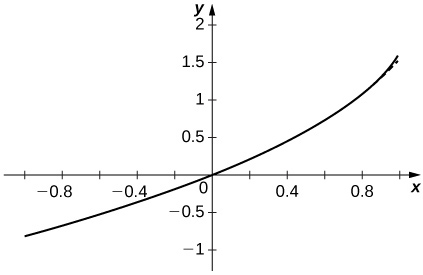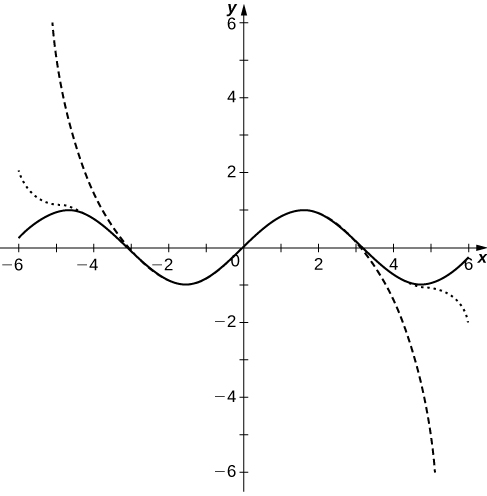1.1E: Exercises
This page is a draft and is under active development.
( \newcommand{\kernel}{\mathrm{null}\,}\)
Exercise 1.1E.1
In the following exercises, state whether each statement is true, or give an example to show that it is false.
1. If ∞∑n=1anxn converges, then anxn→0 as n→∞.
- Answer
-
True. If a series converges then its terms tend to zero.
2. ∞∑n=1anxn converges at x=0 for any real numbers an.
3. Given any sequence an, there is always some R>0, possibly very small, such that ∞∑n=1anxn converges on (−R,R).
- Answer
-
False. It would imply that anxn→0 for |x|<R. If an=nn, then anxn=(nx)n does not tend to zero for any x≠0.
4. If ∞∑n=1anxn has radius of convergence R>0 and if |bn|≤|an| for all n, then the radius of convergence of ∞∑n=1bnxn is greater than or equal to R
Exercise 1.1E.2
1. Suppose that ∞∑n=0an(x−3)n converges at x=6. At which of the following points must the series also converge? Use the fact that if ∑an(x−c)n converges at x, then it converges at any point closer to c than x.
a. x=1
b. x=2
c. x=3
d. x=0
e. x=5.99
f. x=0.000001
- Answer
-
It must converge on (0,6] and hence at: a. x=1; b. x=2; c. x=3; d. x=0; e. x=5.99; and f. x=0.000001.
2. Suppose that ∞∑n=0an(x+1)n converges at x=−2. At which of the following points must the series also converge? Use the fact that if ∑an(x−c)n converges at x, then it converges at any point closer to c than x.
a. x=2
b. x=−1
c. x=−3
d. x=0
e. x=0.99
f. x=0.000001
Exercise 1.1E.3
In the following exercises, suppose that ∣an+1an∣→1 as n→∞. Find the radius of convergence for each series.
1. ∞∑n=0an2nxn
- Answer
-
∣an+12n+1xn+1an2nxn∣=2|x|∣an+1an∣→2|x| so R=12
2. ∞∑n=0anxn2n
- Answer
-
|an+1xn+12n+12nanxn|=|x|2|an+1an∣→|x|2 so R=2
3. ∞∑n=0anπnxnen
- Answer
-
∣an+1(πe)n+1xn+1an(πe)nxn∣=π|x|e∣an+1an∣→π|x|e so R=eπ
4. ∞∑n=0an(−1)nxn10n
- Answer
-
|an+1(−1)n+1xn+110n+110nan(−1)nxn|=|x|10|an+1an∣→|x|10 so R=10
5. ∞∑n=0an(−1)nx2n
- Answer
-
∣an+1(−1)n+1x2n+2an(−1)nx2n∣=∣x2∣∣an+1an∣→∣x2∣ so R=1
6. ∞∑n=0an(−4)nx2n
- Answer
-
∣an+1(−4)n+1x2(n+1)an(−4)nx2n∣=4|x2|∣an+1an∣→4|x2| so R=12
Exercise 1.1E.4
In the following exercises, find the radius of convergence R and interval of convergence for ∑anxn with the given coefficients an.
1. ∞∑n=1(2x)nn
- Answer
-
an=2nn so an+1xan→2x. so R=12. When x=12 the series is harmonic and diverges. When x=−12 the series is alternating harmonic and converges. The interval of convergence is I=[−12,12).
2. ∞∑n=1(−1)nxn√n
- Answer
-
R=1
Interval of convergence (-1,1)
3. ∞∑n=1nxn2n
- Answer
-
an=n2n so an+1xan→x2 so R=2. When x=±2 the series diverges by the divergence test. The interval of convergence is I=(−2,2).
4. ∞∑n=1nxnen
5. ∞∑n=1n2xn2n
- Answer
-
an=n22n so R=2. When x=±2 the series diverges by the divergence test. The interval of convergence is I=(−2,2).
6. ∞∑k=1kexkek
7. ∞∑k=1πkxkkπ
- Answer
-
ak=πkkπ so R=1π. When x=±1π the series is an absolutely convergent p-series. The interval of convergence is I=[−1π,1π].
8. ∞∑n=1xnn!
9. ∞∑n=110nxnn!
- Answer
-
an=10nn!,an+1xan=10xn+1→0<1 so the series converges for all x by the ratio test and I=(−∞,∞).
10. ∞∑n=1(−1)nxnln(2n)
Exercise 1.1E.5
In the following exercises, find the radius of convergence of each series.
1. ∞∑k=1(k!)2xk(2k)!
- Answer
-
ak=(k!)2(2k)! so ak+1ak=(k+1)2(2k+2)(2k+1)→14 so R=4
2. ∞∑n=1(2n)!xnn2n
3. ∞∑k=1k!1⋅3⋅5⋯(2k−1)xk
- Answer
-
ak=k!1⋅3⋅5⋯(2k−1) so ak+1ak=k+12k+1→12 so R=2
4. ∞∑k=12⋅4⋅6⋯2k(2k)!xk
5. ∞∑n=1xn(2nn) where (nk)=n!k!(n−k)!
- Answer
-
an=1(2nn) so an+1an=((n+1)!)2(2n+2)!2n!(n!)2=(n+1)2(2n+2)(2n+1)→14 so R=4
6. ∞∑n=1sin2nxn
Exercise 1.1E.6
In the following exercises, use the ratio test to determine the radius of convergence of each series.
1. ∞∑n=1(n!)3(3n)!xn
- Answer
-
an+1an=(n+1)3(3n+3)(3n+2)(3n+1)→127 so R=27
2. ∞∑n=123n(n!)3(3n)!xn
3. ∞∑n=1n!nnxn
- Answer
-
an=n!nn so an+1an=(n+1)!n!nn(n+1)n+1=(nn+1)n→1e so R=e
4. ∞∑n=1(2n)!n2nxn
Exercise 1.1E.7
In the following exercises, given that 11−x=∞∑n=0xn with convergence in (−1,1), find the power series for each function with the given center a, and identify its interval of convergence.
1. f(x)=1x;a=1 (Hint: 1x=11−(1−x))
- Answer
-
f(x)=∞∑n=0(1−x)n on I=(0,2)
2. f(x)=11−x2;a=0
3. f(x)=x1−x2;a=0
- Answer
-
∞∑n=0x2n+1 on I=(−1,1)
4. f(x)=11+x2;a=0
5. f(x)=x21+x2;a=0
- Answer
-
∞∑n=0(−1)nx2n+2 on I=(−1,1)
6. f(x)=12−x;a=1
7. f(x)=11−2x;a=0.
- Answer
-
∞∑n=02nxn on (−12,12)
8. f(x)=11−4x2;a=0
9. f(x)=x21−4x2;a=0
- Answer
-
∞∑n=04nx2n+2 on (−12,12)
10. f(x)=x25−4x+x2;a=2
Exercise 1.1E.8
Use the next exercise to find the radius of convergence of the given series in the subsequent exercises.
1. Explain why, if |an|1/n→r>0, then |anxn|1/n→|x|r<1 whenever |x|<1r and, therefore, the radius of convergence of ∞∑n=1anxn is R=1r.
- Answer
-
|anxn|1/n=|an|1/n|x|→|x|r as n→∞ and |x|r<1 when |x|<1r. Therefore, ∞∑n=1anxn converges when |x|<1r by the nth root test.
2. ∞∑n=1xnnn
3. ∞∑k=1(k−12k+3)kxk
- Answer
-
ak=(k−12k+3)k so (ak)1/k→12<1 so R=2
4. ∞∑k=1(2k2−1k2+3)kxk
5. ∞∑n=1an=(n1/n−1)nxn
- Answer
-
an=(n1/n−1)n so (an)1/n→0 so R=∞
6. Suppose that p(x)=∞∑n=0anxn such that an=0 if n is even. Explain why p(x)=p(−x).
7. Suppose that p(x)=∞∑n=0anxn such that an=0 if n is odd. Explain why p(x)=−p(−x).
- Answer
-
We can rewrite p(x)=∞∑n=0a2n+1x2n+1 and p(x)=p(−x) since x2n+1=−(−x)2n+1.
8. Suppose that p(x)=∞∑n=0anxn converges on (−1,1]. Find the interval of convergence of p(Ax).
9. Suppose that p(x)=∞∑n=0anxn converges on (−1,1]. Find the interval of convergence of p(2x−1).
- Answer
-
If x∈[0,1], then y=2x−1∈[−1,1] so p(2x−1)=p(y)=∞∑n=0anyn converges.
Exercise 1.1E.9
In the following exercises, suppose that p(x)=∞∑n=0anxn satisfies lim where \displaystyle a_n≥0 for each \displaystyle n. State whether each series converges on the full interval \displaystyle (−1,1), or if there is not enough information to draw a conclusion. Use the comparison test when appropriate.
1. \displaystyle \sum_{n=0}^∞a_nx^{2n}
2. \displaystyle \sum_{n=0}^∞a_{2n}x^{2n}
- Answer
-
Converges on \displaystyle (−1,1) by the ratio test
3. \displaystyle \sum_{n=0}^∞a_{2n}x^n (Hint:\displaystyle x=±\sqrt{x^2})
4. \displaystyle \sum_{n=0}^∞a_{n^2}x^{n^2} (Hint: Let \displaystyle b_k=a_k if \displaystyle k=n^2 for some \displaystyle n, otherwise \displaystyle b_k=0.
- Answer
-
Consider the series \displaystyle \sum b_kx^k where \displaystyle b_k=a_k if \displaystyle k=n^2 and \displaystyle b_k=0 otherwise. Then \displaystyle b_k≤a_k and so the series converges on \displaystyle (−1,1) by the comparison test.
5. Suppose that \displaystyle p(x) is a polynomial of degree \displaystyle N. Find the radius and interval of convergence of \displaystyle \sum_{n=1}^∞p(n)x^n.
Exercise \PageIndex{10}
1. Plot the graphs of \displaystyle \frac{1}{1−x} and of the partial sums \displaystyle S_N=\sum_{n=0}^Nx^n for \displaystyle n=10,20,30 on the interval \displaystyle [−0.99,0.99]. Comment on the approximation of \displaystyle \frac{1}{1−x} by \displaystyle S_N near \displaystyle x=−1 and near \displaystyle x=1 as \displaystyle N increases.
- Answer
-
The approximation is more accurate near \displaystyle x=−1. The partial sums follow \displaystyle \frac{1}{1−x} more closely as \displaystyle N increases but are never accurate near \displaystyle x=1 since the series diverges there.

2. Plot the graphs of \displaystyle −ln(1−x) and of the partial sums \displaystyle S_N=\sum_{n=1}^N\frac{x^n}{n} for \displaystyle n=10,50,100 on the interval \displaystyle [−0.99,0.99]. Comment on the behavior of the sums near \displaystyle x=−1 and near \displaystyle x=1 as \displaystyle N increases.
3. Plot the graphs of the partial sums \displaystyle S_n=\sum_{n=1}^N\frac{x^n}{n^2} for \displaystyle n=10,50,100 on the interval \displaystyle [−0.99,0.99]. Comment on the behavior of the sums near \displaystyle x=−1 and near \displaystyle x=1 as \displaystyle N increases.
- Answer
-
The approximation appears to stabilize quickly near both \displaystyle x=±1.

4. Plot the graphs of the partial sums \displaystyle S_N=\sum_{n=1}^Nsinnx^n for \displaystyle n=10,50,100 on the interval \displaystyle [−0.99,0.99]. Comment on the behavior of the sums near \displaystyle x=−1 and near \displaystyle x=1 as \displaystyle N increases.
5. Plot the graphs of the partial sums \displaystyle S_N=\sum_{n=0}^N(−1)^n\frac{x^{2n+1}}{(2n+1)!} for \displaystyle n=3,5,10 on the interval \displaystyle [−2π,2π]. Comment on how these plots approximate \displaystyle sinx as \displaystyle N increases.
- Answer
-
The polynomial curves have roots close to those of \displaystyle sinx up to their degree and then the polynomials diverge from \displaystyle sinx.

6. Plot the graphs of the partial sums \displaystyle S_N=\sum_{n=0}^N(−1)^n\frac{x^{2n}}{(2n)!} for \displaystyle n=3 ,5,10 on the interval \displaystyle [−2π,2π]. Comment on how these plots approximate \displaystyle cosx as \displaystyle N increases.


